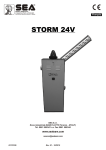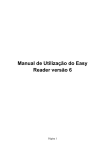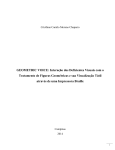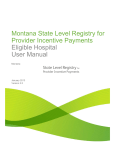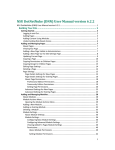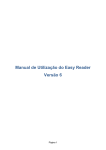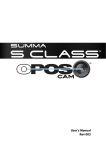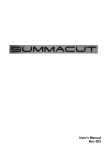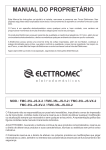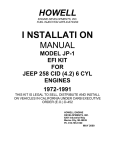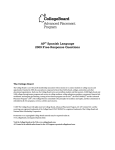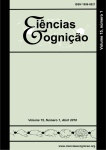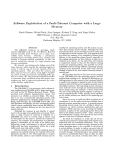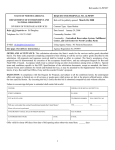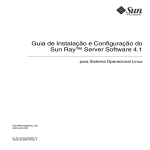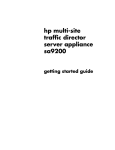Download Winter 2008 - North Carolina Teachers of Advanced Placement
Transcript
The North Carolina Association Of Advanced Placement* Mathematics Teachers Newsletter * * * * * * * * * * * * * * * * Volume 16 Winter 2008 Board Members Deborah Britt – Executive Secretary Jeff Lucia – Treasurer/Membership Chair Stephen Davis – Web Master Rhea Caldwell – Western Region Gloria Dupree – President-Elect, Western Region Ray Jernigan – President, Eastern Region Emogene Kernodle – Central Region Patricia Morris – Immediate Past President, Central Region Martha Ray – Central Region David Royster – College Representative, Western Region Dan Teague – Central Region Sue Wall – Eastern Region Issue No. 1 Web Address www.ncaapmt.org/calculus Notes from the President’s Desk I hope you’re having a great year. You job is always busy: trying to find ways to integrate a variety of topics in problem solving contexts; differentiate tasks to meet the needs of students; encouraging students to maximize their potential; finding and “plugging” the points of discontinuity and more. Summing it up, you have a difficult (sometimes pushing you to your limit) but very important role as a teacher. As I conclude my term as president, I’d like to say thank you for serving in the teaching profession and thank you for teaching and developing mathematicians of the future. Please invite a friend to join NCAAPMT and please let us know how we can better support you in the classroom. Ray Jernigan *Advanced Placement is a registered trademark of The College Board, which was not involved in the production of, and does not endorse, this publication. 1 Notes from the Secretary’s Desk It has been a fast year. My dissertation is coming along. All my interviews are complete, transcribed and coded. The writing is going well at times and then slow at times. But it is exciting to see that there really is an end in sight. I am job-hunting for Fall of 2008 so all the paperwork is a pain at times and it keeps me busy. If anyone knows of a position that allows me to still live in Mars Hill, NC, please contact me! I have one AP workshop to do in March and that should complete the year. I will be attending the AP reading this summer – so our question writers for the summer newsletter will know me personally! Please remember to renew your membership to receive the two newsletters. You can send your $5.00 check, payable to NCA2PMT, to Jeff Lucia, 718 Lansdowne Road, Charlotte, NC 28270. His email address is [email protected]. We want to serve you. If you have items of interest, please pass them on to me. Deb Britt, Mars Hill, NC, [email protected] Table of Contents Page Numbers Calculus Challenge …………………………………………………………. Calculus Lab ………………………………………………………………... Calculus Essay ................................................................................................ Inverse Functions …………………………………………………………… Slopefield Resources ................................................................................…... Math Videos & Cartoons …………………………………………………... TI-Nspire ……………………………………………………………………. College Board Resources …………………………………………………... By the Numbers …………………………………………………………….. AP Course Audit …………………………………………………………… Resources …………………………………………………………………… Ideas from Teachers ………………………………………………………... Conferences …………………………………………………………………. 2 11 12 14 14 15 15 16 17 17 18 20 23 Calculus Challenge The North Carolina Association of Advanced Placement Mathematics Teachers (website can be found at http://www.ncaapmt.org/calculus/) is hosting a series of challenge problems for calculus classes this year. The Calculus Challenge is open to any calculus class in NC and to the classes of NCAAPMT members from outside NC. Of course, the problems will be available to everyone and any class is welcome to work on the problems if they find them interesting. New problems will be presented every two weeks. These will be somewhat non-standard problems that will allow students to work together and share ideas and approaches, practice writing solutions with good mathematical notation, and offer them an opportunity to problem solve using techniques of calculus. The problems will attempt to follow the AP AB curriculum through the year. We will make every effort to keep the problems challenging but within the capabilities of calculus students working together. We encourage classes to participate as a team and submit solutions from the class. This allows the students the opportunity to practice both writing and reading mathematics. We want the students to have to work hard on the problems, but if they do, they should be able to get some good results. Partial solutions will be accepted. Some problems will involve theory, some applications and modeling. We hope that all of them will be different from the standard homework problems and require students to expand their capabilities. We hope all of them will be interesting and fun and that students will 2 look forward to working on them every two weeks. The classroom teacher can act as an advisor, but cannot contribute to the student's solutions. The solutions from NC and NCAAPMT member classes will be scored and the teacher whose class scores the most points during the year will receive a plaque honoring their students' efforts. After two weeks, a solution will be presented along with a new problem. Particularly interesting student solutions will also be shared. If you have any questions or concerns, please contact Dan Teague at [email protected]. What follows are some samples of our work so far: Selected Problems from the NCAAPMT Calculus Challenge Problem #3 In class, you have learned the definition of derivative. We know that f # (x ) = lim f (x + h ) " f (x ) , h whenever the limit exists. The derivative of a function is another function, so we can find its derivative as well. The derivative of the derivative is known as the second derivative and is denoted f !! (x ) . h !0 a) Find a limit definition for f !! (x ) similar to f # (x ) = lim f (x + h ) " f (x ) h h !0 and using only values of f. (do not use f ! in your limit statement) We know that f # (x ) = f (x + h ) " f (x ) d d f ! (x ) . and that f !! (x ) = f (x ) = lim h ! 0 dx dx h To make it a little easier to read, define function g to be the derivative of f, so g (x ) = f ! (x ) . g (x + h ) " g (x ) f (x + h ) " f (x ) d . So g (x ) = lim and g (x ) = lim h !0 h !0 dx h h f ((x + h ) + h )" f (x + h ) . g (x + h ) = lim h !0 h " f ((x + h ) + h )$ f (x + h ) f (x + h ) $ f (x ) # $ lim % lim & " g (x + h ) $ g (x ) # h !0 h ! 0 h h & So, f '' (x ) = lim % = lim % & h !0 & h h ( ) h !0 % % & ( ) We know that the limit of a sum is the sum of the limits, so we have We want g # (x ) = ( ((x + h ) + h )$ f (x + h ) $ f (x + h ) + f (x ))#& " f f '' (x ) = lim % lim h !0 % h !0 ( and ( ) h2 & ) " ( f (x + 2h ) $ 2 f (x + h ) + f (x ))#' . f %% (x ) = lim & lim h !0 & h !0 ' h2 ( ) Also, lim lim Q (x ) is just lim (Q (x )). The composed limit statements are redundant. So, we have h !0 h !0 h !0 # f ( x + 2h ) " 2 f ( x + h ) + f ( x ) $ f %% (x ) = lim & '. h !0 h2 ( ) 3 Before we try our definition on a messy cubic, let’s try it on something simple, like before we go too far down the wrong track. If f (x ) = x 2 , then f (x ) = x 2 " f ( x + 2h ) ! 2 f ( x + h ) + f ( x ) # ( x + 2h ) ! 2 ( x + h ) + x 2 . Simplifying, we have $ %= h2 h2 & ' 2 ( x + 2h ) 2 ! 2 (x + h ) + x 2 2 h 2 = 2 x 2 + 4hx + 4h 2 ! 2 x 2 ! 4 xh ! 2h 2 + x 2 =2 h2 # f ( x + 2h ) " 2 f ( x + h ) + f ( x ) $ So, f %% (x ) = lim & 2 = 2 and the second derivative of x 2 is 2. That ' = lim 2 h !0 h !0 h ( ) looks good. b) Use this limit definition to show that if f (x ) = a0 + a1 x + a2 x 2 + a3 x 3 , then f !! (x ) = 2a2 + 6a3 x . (1 pt) OK. Now, let’s try f (x ) = a0 + a1 x + a2 x 2 + a3 x 3 . We need expressions for f (x + 2h ) , f (x + h ) , and f (x ) . f (x ) = a0 + a1 x + a2 x 2 + a3 x 3 , f (x + h ) = a0 + a1 (x + h ) + a2 (x + h ) + a3 (x + h ) , and 2 3 f (x + 2h ) = a0 + a1 (x + 2h ) + a2 (x + 2h ) + a3 (x + 2h ) . So, substituting the above expressions into our 2 difference quotient 3 f ( x + 2h ) ! 2 f ( x + h ) + f ( x ) h gives the expanded expression ( ) a0 + a1 (x + 2h ) + a2 (x + 2h ) + a3 (x + 2h ) ! 2 a0 + a1 (x + h ) + a2 (x + h ) + a3 (x + h ) + a0 + a1 x + a2 x 2 + a3 x 3 2 3 2 3 h2 Now, multiply everything out and we have " f ( x + 2h ) ! 2 f ( x + h ) + f ( x ) # $ % h2 & ' 2 a0 + a1 x + 2a1h + a2 x + 4a2 h + 4a2 h 2 + a3 x 3 + 6a3 hx 2 + 12a3 h 2 x + 8a3 h3 = h2 2 !2a0 ! 2a1 x ! 2a1h ! 2a2 x ! 4a2 h ! 2a2 h 2 ! 2a3 x 3 ! 6a3 hx 2 ! 6a3 h 2 x ! 2a3 h3 + h2 2 3 a + a x + a2 x + a3 x + 0 1 h2 Combining like terms, this simplifies to " f ( x + 2h ) ! 2 f ( x + h ) + f ( x ) # $ %= h2 & ' 2a2 h 2 + 6a3 h 2 x + 6a3 h3 = 2a2 + 6a3 x + 6a3 h . h2 # f ( x + 2h ) " 2 f ( x + h ) + f ( x ) $ So, f %% (x ) = lim & (2a2 + 6a3 x + 6a3 h ) = 2a2 + 6a3 x . ' = lim h !0 h2 ( ) h !0 Our limit definition seems to be working. c) Generalize your limit definition to find the nth derivative, dn f (x ) , in terms of f only. (1 pt) dx n 4 To generalize this result, let’s consider the third derivative. We need to replace function g in g (x + h ) " g (x ) " f ( x + 2h ) ! 2 f ( x + h ) + f ( x ) # with $ lim % and see if we can see a pattern. If you see a h !0 h h2 & ' pattern, try to explain why the pattern exists or how it is created. Replacing function g in lim g (x + h ) " g (x ) h h !0 " f ( x + 2h ) ! 2 f ( x + h ) + f ( x ) # with $ % gives us h2 & ' # f (x + 3h ) " 2 f (x + 2h ) + f (x + h ) $ # f (x + 2h ) " 2 f (x + h ) + f (x ) $ % &"% & h2 h2 ( ' ( lim ' h !0 h which simplifies to lim f (x + 3h ) " 3 f (x + 2h ) + 3 f (x + h ) " f (x ) . h3 Notice how the terms in the numerator combined. The “like terms” in each expression have the same sign and add together. h !0 For the 4th derivative, we replace function g in lim g (x + h ) " g (x ) h h !0 f (x + 3h ) ! 3 f (x + 2h ) + 3 f (x + h ) ! f (x ) with . This gives h3 f (x + 4h ) " 3 f (x + 3h ) + 3 f (x + 2h ) " f (x + h ) f (x + 3h ) " 3 f (x + 2h ) + 3 f (x + h ) " f (x ) " h3 h3 lim h !0 h which simplifies to f (x + 4h ) " 4 f (x + 3h ) + 6 f (x + 2h ) " 4 f (x + h ) + f (x ) . lim h !0 h4 Again, look how the terms in the numerator combine. If this looks familiar, you are right. The coefficients combine in the same added way as the elements in Pascal’s triangle. 1 1 1 1 1 1 2 3 4 5 1 1 3 6 10 1 4 10 1 5 1 5 !n" These coefficients are known as binomial coefficients, denoted # $ . In general, we see that %k & "n# "n# "n# n "n# % & f (x + nh ) $ % & f (x + (n $ 1)h )+ % & f (x + (n $ 2 )h )$ ! + ($1) % & f (x ) n 0 d '1( ' 2( 'n( f (x ) = lim ' ( h !0 dx n hn Problem #4 Adding with Derivatives We know that the infinite geometric series 1 + x + x 2 + x 3 + x 4 + ! = 1 is known as the closed form of the series. 1! x 2 3 4 1 3 1 + (13 )+ (13 ) + (13 ) + (13 ) + ! = = . 1 1 ! (3 ) 2 The expression a) First show that if 1 + x + x 2 + x 3 + ! = whenever 1 whenever x < 1 . 1! x Using the closed form, we know that 1 1 whenever x < 1 , then 1 + 2 x + 3 x 2 + 4 x 3 + ! = 2 1! x (1 ! x ) x < 1 . Find 1 + 2 (13 )+ 3 (13 ) + 4 (13 ) +! (1 pt) 2 3 1 whenever x < 1 , so by differentiating both sides of this 1! x 1 equation, we have 1 + 2 x + 3 x 2 + 4 x 3 + ! = whenever x < 1 . To determine the sum of the infinite 2 (1 ! x ) We know that 1 + x + x 2 + x 3 + x 4 + ! = series 1 + 2 (13 )+ 3 (13 ) + 4 (13 ) + 5 (13 ) +! we just evaluate the closed form at x = 13 . The closed form for 2 3 4 a series is known as the generating function for that series, so we typically denote it as G (x ) . If G (x ) = b) 1 (1 ! x ) 2 , then G (13 ) = 1 (1 ! ) 1 2 3 = 9 . 4 So, 1 + 2 (13 )+ 3 (13 ) + 4 (13 ) + 5 (13 ) + ! = 94 . 2 3 4 Find a closed form for x + 2 x 2 + 3 x 3 + 4 x 4 + 5 x 5 +! . Modify your expression to find the sum of 1 + 4 (13 )+ 9 (13 ) + 16 (13 ) + 25 (13 ) +! 2 3 4 We know that 1 + x + x 2 + x 3 + x 4 + ! = 1 1 and 1 + 2 x + 3 x 2 + 4 x 3 + ! = . How do we find a 2 1! x (1 ! x ) closed form for x + 2 x 2 + 3 x 3 + 4 x 4 + 5 x 5 +! ? If we multiply our second series by x (x ! 0 ) , we have x + 2 x 2 + 3x3 + 4 x 4 + ! = x (1 ! x ) 2 whenever x < 1 . How do we use this to sum 1 + 4 (13 )+ 9 (13 ) + 16 (13 ) + 25 (13 ) +! ? We need to find the closed form for 2 3 1 + 4 x + 9 x 2 + 16 x 3 + 25 x 4 +! and evaluate at x = 13 . 4 Notice that 1 + 4 x + 9 x 2 + 16 x 3 + 25 x 4 +! is the 6 derivative of x + 2 x 2 + 3 x 3 + 4 x 4 + 5 x 5 ! , so its closed form should be the derivative of x + 2 x 2 + 3x3 + 4 x 4 + ! = x (1 ! x ) 2 1 + 4 x + 9 x + 16 x + 25 x G (x ) = 3 1+ x (1 ! x ) 3 4 (1 + x ) (1) ! x (2 )(x ! 1) (!1) 1 + x +! = = 4 3 (1 ! x ) (1 ! x ) . Evaluating at x = 1 3 c) 3 2 If 4 1 + 13 (1 ! ) 1 3 3 whenever x < 1 . Now 9 . So, 2 = 9 . 2 1 ! 4 (13 )+ 9 (13 ) ! 16 (13 ) + 25 (13 ) +! 2 3 4 The coefficients are squares as before, but they alternate in sign. We know that 1+ x whenever x < 1 . If we replace x with 1 + 4 x + 9 x 2 + 16 x 3 + 25 x 4 + ! = 3 (1 ! x ) ! x , we have 1 + 4 (! x ) + 9 (! x ) + 16 (! x ) + 25 (! x ) + ! = This is just 2 3 4 1 ! 4 x + 9 x 2 ! 16 x 3 + 25 x 4 + ! = give us G (13 ) = d) . 1 give us G (13 ) = 1 + 4 (13 )+ 9 (13 ) + 16 (13 ) + 25 (13 ) + ! = 2 (1 ! x ) whenever x < 1 , then 2 2 x 1 ! 13 (1 + ) 1 3 3 = 9 . 32 1! x (1 + x ) 3 1 + (! x ) (1 ! (! x )) 3 whenever x < 1 . whenever (! x ) < 1 . So, G (x ) = 1! x (1 + x ) 3 . Evaluating at x = This means that 1 + 4 (13 )+ 9 (13 ) + 16 (13 ) + 25 (13 ) + ! = 2 3 4 1 3 9 . 32 1(13 ) + 8 (13 ) + 27 (13 ) + 64 (13 ) + 125 (13 ) +! 2 4 6 8 10 OK. Now they are starting to get tricky. We need to find the closed form for the series 1x 2 + 8 x 4 + 27 x 6 + 64 x8 + 125 x10 +! . The coefficients are cubes and the powers jump by two and they don’t start with a constant. 1+ x First, let’s deal with the powers. We know that 1 + 4 x + 9 x 2 + 16 x 3 + 25 x 4 + ! = 3 (1 ! x ) whenever x < 1 . If we differentiate now, we get 4 + 18 x + 48 x 2 +! . That’s not what we want. If we multiply both sides by x, we have x + 4 x 2 + 9 x 3 + 16 x 4 + 25 x 5 + ! = x (1 + x ) (1 ! x ) 3 . Now differentiate both sides of the equation (and be careful with the quotient rule). So, x2 + 4x + 1 . That gets the coefficients right. 1 + 8 x + 27 x 2 + 64 x 3 + 125 x 4 + ! = 4 (1 ! x ) 7 Now for the powers. If 1 + 8 x + 27 x 2 + 64 x 3 + 125 x 4 + ! = replacing x with x 2 we have 1 + 8 x 2 + 27 x 4 + 64 x 6 + 125 x8 + ! = x2 + 4x + 1 (1 ! x ) 4 x4 + 4x2 + 1 (1 ! x ) 2 4 , whenever x < 1 , then by , whenever x 2 < 1 We are close to what we want. Now multiply both sides of the equation by x 2 . So, 1x 2 + 8 x 4 + 27 x 6 + 64 x8 + ! = (13 ) 2 whenever x 2 < 1 . Since G( 1 3 ) (1 ) = 3 6 + 4 (13 ) + (13 ) 4 2 (1 ! ( ) ) 4 1 2 3 = < 1 we are OK. So, G (x ) = x6 + 4 x4 + x2 (1 ! x ) 2 4 e) (1 ! x ) 2 4 , and 531 . 2048 The sum is 1(13 ) + 8 (13 ) + 27 (13 ) + 64 (13 ) + 125 (13 ) + ! = 2 x6 + 4 x4 + x2 4 6 8 10 531 . 2048 1(13 )+ ( 12 )(13 ) + (13 )(13 ) + ( 14 )(13 ) + (15 )(13 ) +! (1 pt) 2 3 4 5 What is the generating function for 1x + (12 ) x 2 + (13 ) x 3 + (14 ) x 4 + (15 ) x 5 +! ? We need to think backwards on this one. We must notice that 1 + x + x 2 + x 3 + x 4 + x 5 +! is the derivative of 1 1x + (12 ) x 2 + (13 ) x 3 + (14 ) x 4 + (15 ) x 5 +! . So, must be the derivative of the generating function we 1! x 1 d !1 1 ! ln (1 ! x )) = are after. What function has as its derivative? Well, (don’t (!1) = ( 1! x dx 1! x 1! x forget the chain rule). So, does 1x + ( 12 ) x 2 + (13 ) x 3 + ( 14 ) x 4 + (15 ) x 5 + ! = ! ln (1 ! x ) , whenever x < 1 . Notice that the values match at x = 0 . So, G (x ) = ! ln (1 ! x ) and G (13 ) = ! ln ( 23 ). The sum is approximated by 0.405465. Super Challenge: 0 + 1(13 )+ 1(13 ) + 2 (13 ) + 3 (13 ) + 5 (13 ) + 8 (13 ) + 13 (13 ) ! (the coefficients are the 2 3 4 5 6 7 Fibonacci numbers) No one is supposed to have gotten this one. I just wanted you to see how these kinds of things are done. To find a generating function like this one, we assume one exists and try to find its structure. In this case we say that G (x ) = a0 + a1 x + a2 x 2 + a3 x 3 + a4 x 4 + a5 x 5 +! and we know that the coefficients are defined by the Fibonacci recursion a0 = 0, a1 = 1, and an + 2 = an +1 + an (sometimes it is convenient to start with 1, 1, 2, 3, 5, 8, … and other times 0, 1, ,1, 2, 3, 5, 8, …). In this case we want the first term to be 0. So, if an + 2 = an +1 + an , we multiply both sides of this equation by x n and evaluate for n = 0,1, 2,3… . n = 0,1, 2,3… an + 2 (x n ) = an +1 (x n )+ an (x n ) n=0 a2 = a1 + a0 n=1 a3 (x ) = a2 (x ) + a1 (x ) 8 a4 (x 2 ) = a3 (x 2 )+ a2 (x 2 ) n=2 a5 (x 3 ) = a4 (x 3 )+ a3 (x 3 ) n=3 a6 (x 4 ) = a5 (x 3 )+ a4 (x 4 ) n=4 a7 (x 5 ) = a6 (x 5 )+ a5 (x 5 ) n=5 Now, add up the equations in the second column. We have a2 + a3 x + a4 x 2 + a5 x 3 + a6 x 4 + ! = a1 + a2 x + a3 x 2 + a4 x 3 ! + a0 + a1 x + a2 x 2 + a3 x 3 + ! . We have ( ) ( ) three series that are each a modification of our proposed generating function G (x ) . The left side of the equation is G (x ) with the first two terms gone and some x’s divided out. We can write a2 + a3 x + a4 x 2 + a5 x 3 + a6 x 4 + a7 x 5 + ! = G (x ) ! a0 ! a1 x x2 . Make sure you believe that statement before proceeding. The right hand side has two variations of G (x ) . The first is a1 + a2 x + a3 x 2 + a4 x 3 + a5 x 4 ! = G (x ) ! a0 x while the second is just a0 + a1 x + a2 x + a3 x 3 + ! = G (x ) . So, 2 a2 + a3 x + a4 x 2 + a5 x 3 + a6 x 4 + ! = (a1 + a2 x + a3 x 2 + a4 x 3 !)+ (a0 + a1 x + a2 x 2 + a3 x 3 + !) can be rewritten as G (x ) ! a0 ! a1 x Solve for G (x ) . x 2 = G (x ) ! a0 So, G (x ) ! a0 ! a1 x = xG (x ) ! a0 x + x 2 G (x ) and G (x ) = x + G (x ) . a0 x ! a0 ! a1 x . We also know that x2 + x ! 1 a0 = 0, a1 = 1, so G (x ) = ! (13 ) !x 3 1 . Finally, we have G = = . ( ) 3 2 2 1 1 x + x !1 (3 ) + (3 ) ! 1 5 !x actually represents the infinite series x + x !1 0 + 1x + 1x 2 + 2 x 3 + 3 x 4 + 5 x 5 + 8 x 6 + 13 x 7 ! is an important one that we cannot answer with the mathematics that you presently know. It turns out that !x 5 !1 0 + 1x + 1x 2 + 2 x 3 + 3 x 4 + 5 x 5 + 8 x 6 + 13 x 7 ! = 2 , for x < . x + x !1 2 !x To convince yourself that G (x ) = 2 actually generates the Fibonacci series, just do the long x + x !1 division and see how the terms are created. The question of for what values G (x ) = 2 Problem #7 A student is standing on top of a building B feet tall. At a point h feet above her eye on the top of a building L feet away, a brick is dropped. Assume air resistance is negligible so that the acceleration due to ft gravity is g . If the student rotates her head to keep her eye on the brick as she watches it fall, sec 2 determine the height of the brick at the point in the brick’s descent when the student’s head is moving most quickly. 9 First, we draw a diagram. The figure at right represents the situation. We let the variable y represent the position of the brick measured from horizontal. So a negative value for y indicates a y # y$ position below eye-level. We see that tan (! ) = , so ! = Tan "1 % & . L 'L( 2 dy d y = ! gt + c . Since the initial velocity is Also note that = ! g , so 2 dt dt dy = ! gt . Further, if 0 (the brick is dropped, not thrown), we have dt dy = ! gt , then y = h ! 12 gt 2 . dt d! 1 # y$ # y" $ = If ! = Tan "1 % & , then & . Simplify this expression 2 % dt 'L( # y$ ' L( 1+ % & 'L( 2 Ly " # y" $ # L $ # y" $ . % &=% 2 &= 2 2 &% L L L + y L + y2 # y$ ' ( ' (' ( 1+ % & 'L( d! " Lgt = . We want to maximize . 2 dt L + (h " 1 gt 2 )2 and substitute y ! = " gt and y = h ! 12 gt 2 . Finally, d! Ly " # Lgt = 2 = 2 2 2 dt L + y L + (h # 12 gt 2 ) So, d! = dt 1 2 2 Now we have a classic optimization problem. Differentiate using the quotient rule and set the derivative equal to zero. $ d! & ( dt ( ) ( L2 + (h " 12 gt 2 ) (" Lg ) " (" Lgt )(2 )(h " 12 gt 2 )(" gt ) %# . ' = 2 2 2 2 ) 1 L + (h " 2 gt ) 2 ) The denominator is always positive, so we don’t need to worry about a critical value where the derivative does not exist. From the numerator, factor out (! Lg ) and multiply everything out, so ! " g 2t 4 0 = (# Lg )$ L2 + h 2 # hgt 2 + + 2 ght 2 # g 2 t 4 % . 4 & ' 3g 2t 4 . We can solve this 4 equation for t 2 , which is all we need to find y = h ! 12 gt 2 . Using the quadratic formula, we have ( ) Combine terms to arrive at the 4th degree equation: 0 = L2 + h 2 + hgt 2 ! t2 = 2h + 4h 2 + 3L2 . Since t 2 must be positive, we use the sum rather than the difference solution. 3g ! 2h + 4h 2 + 3L2 So y = h % 12 gt 2 = h % (12 g )# # 3g & " 2h 4h 2 + 3L2 . Finally, the height of the brick $= % $ 3 6 ' 2h 4h 2 + 3L2 ! . As a test case, consider L = 50, g = 32 , B = 150 , and 3 6 h = 30 . Then t 2 = 1.7225, y = 2.4406 , and the height of the brick is 152.4406 feet. If the distance at this point is B + y = B + between buildings is 100 feet, then L = 100, g = 32 , B = 150 , and h = 30 . Then t 2 = 2.5344, y = !10.5505 , and the height of the brick is 139.4495 feet. 10 Calculus Lab - Volumes of Solids of Revolution Doris Rowe – West Rowan High School, Salisbury, NC This is a group activity. I’ve chosen and numbered six containers (mainly bottles), each with a different shape from the others. Each group will draw a number to determine which container they will use for the activity. Materials Needed: • Container provided by teacher • Ruler, tape measure, or calipers (for measuring length in centimeters) • Graphing calculator and Maple software • Measuring cups or graduated beakers (for measuring volume in mL) • Water • Camera • Coordinate grid with centimeter increments Directions: 1. Read all the directions before beginning lab. Also, determine what you think the objective of this lab is. 2. Measure and record the various radii of your container, as well as the overall length (use centimeters!). Depending on your container, you may want to measure several “sub-lengths”. 3. Based on your measurements and your knowledge of functions, determine a piecewise function that could be rotated around the x-axis to create the shape (or a close approximation) of your container. Also, make the bottom of your container coincide with the y-axis. Graph this piecewise function in your calculator or with Maple (see me for help). 4. Use Maple to graph the solid formed by revolving your piecewise function around the x-axis (see me for help). 5. Using your piecewise function and your knowledge of calculus, compute the volume of your container in cubic centimeters. 6. Measure the capacity (volume) of your container in mL. 7. Compare your calculated volume to your measured volume (recall from science class that 1 cubic centimeter = 1 milliliter). Compute your percent error. Make a statement regarding the accuracy of your calculation. That is, make a judgment on how “good” or accurate you think your calculated volume was and explain the difference between it and the measured volume. 8. Take a picture of your container in front of the coordinate grid marked by centimeters (I’m providing one for the class to use). Be sure to orient your container so that its axial center coincides with the x-axis and its bottom coincides with the y-axis. 9. Type your lab report including everything listed in the rubric below. With the exception of the description of your measurements, use compete sentences throughout your report. Rubric: 5 5 10 20 10 10 5 25 5 5 Objective of lab Name and description of the shape of your container (ex: wine bottle, wide base, narrow top) Recorded measurements, neatly presented in a table, with written description Piecewise function Graph of piecewise function Graph of solid of revolution Picture of container against grid Integrals used to calculate the volume and their total Measured volume of container Comparison of volumes, percent error*, and statement regarding accuracy *Five additional points will be awarded to the group with the smallest percent error. 11 AP Calculus Essay: Integration & Differential Equations Doris Rowe - West Rowan High School, Salisbury, NC You SHOULD work with a partner on this essay. Type your responses to the following prompts. For the examples, use either the TI-connect, MS Equation Editor, or cut-and-paste from web sites or other resources. If you use a resource other than your textbook, be sure to cite it. 1. In your own words, explain the classic problem of calculus that integrals solve. 2. Describe the two approximation methods for finding areas. Give an example of a function (choose one that would require more than a simple power rule when antidifferentiating – see #5), an interval, and a number of subintervals. Show a graph of the function on the interval with the rectangles or trapezoids drawn under it. Show the approximate area determined by that method. 3. Give a definition of an integral. 4. What must be true of a function for it to be integrable? 5. Integrate the function you gave in #2 on the interval you chose. Show all steps and explain each step. Compare this result with your approximation. What would have made your answers even closer? 6. What is a differential equation? What does it mean to solve a differential equation? 7. What is Newton’s Law of Cooling? Describe in words and give the basic equation. 8. Perform the Newton’s Law of Cooling Experiment described on the back of this page. Describe your experiment (What substance did you use? Did it start in the oven or the freezer? How often did you measure and record temperature?). Insert all required items into your essay. 9. Make a “conclusion” type of statement that ties together all of the above info on integrals. Grading Rubric: 5 5 5 5 5 5 5 5 5 5 5 5 5 5 5 5 5 5 5 5 Explained classic problem of calculus Described two approximation methods for finding areas Gave function, interval, number of subintervals Showed graph with rectangles/trapezoids drawn under it Showed approximate area Gave definition of integral Stated what must be true of a function for it to be integrable Integrated the function from #2 Explained all steps adequately Compared results and explained how to get better approximation Stated what a differential equation is Explained what it means to solve a differential equation Explained what Newton’s Law of Cooling is and gave equation. Described experiment Picture of yourself performing experiment Data table Steps used to solve for C and k, and final model (equation) Graph of data and model Statement regarding accuracy Conclusion statement NOTE: There is an opportunity to earn 5 extra credit points with this essay – it is described below. 12 Experiment Portion of Essay Newton’s Law of Cooling Materials needed: • Thermometer (preferably a meat thermometer if using the oven) • Watch • *A substance (such as a cake or a large piece of meat – nothing too small) into which you can stick the thermometer • Camera. Directions: 1. Start with your substance in an oven or a freezer, or some place that is significantly different in temperature from your house. 2. Choose a room in your house whose temperature does not fluctuate easily. Measure and record the temperature of that room. 3. Have someone take a picture of you doing this step. Measure and record the temperature of your substance when first removed from oven, freezer, or other location. Move the substance to the room you chose in step 2. 4. Continue to measure and record the temperature of your substance three more times, for a total of four data points (be sure to record the times at which you take the temperatures). 5. Use the first two time/temperature data points to solve for C and k in Newton’s Law of Cooling. 6. With your graphing calculator, plot the points and your model together. (Use the data/matrix editor to enter the points. Enter your equation in the y= screen.) 7. In your essay, insert a picture of yourselves conducting the experiment, your data table, your equation (and the steps you took to solve for C and k), and your graph. 8. Make a statement about the accuracy and prediction value of your equation. *Extra Credit opportunity: If your experimental substance is something that the class can eat, bring it in to earn 5 extra points. 13 Inverse Functions Y1 = X+.5abs(X-1) {or any other fctn in question} Y2 = solve(Y1(Z)-X,Z,2) {to get the inverse of Y1 } ZOOM 4 to have a square window. Note that the graphical CALC features work. Try [2nd], TRACE, 6, ^(to be tracing on Y2, the inverse of Y1) and then ENTER to get the slope of Y2 at the abscissa you had. Try option 7 to be dazzled with the shading. On the Home screen, nDeriv(Y2(X),X,-.2) gives the slope to be 2. fnInt(Y1(X),X,0,2) gives 1.333333. TI 82, 83 and 84 support this. Steve Just a bit about the TI drawinv command: I don't use it when demonstrating on my overhead display calculator, because it is easier for me to just turn the display screen over on its back and give it a quarter turn. This is equivalent to reflecting the graph over y = x. It really reinforces the idea of the reflection in students' minds. There's no possibility that the calculator is doing some kind of "magic" to get the picture of the inverse. Of course, students can't do this trick with their own calculators. Dave "When does a function have an inverse that is also a function?" Answer: When it is one-to-one. Obviously, some functions have inverses that are not function (e.g. y = x^2 becomes x = y^2 not a function). You need to make a distinction between the two possibilities. If the inverse is not a function (e.g. the inverse trig functions, y = x^2 etc) then a restriction of the range is often used to make the inverse a function. I believe calculators graph inverses by plotting the point (y, x) for each (x, y) that belongs to the function. Incidentally, since you cannot trace the graph produced by the "Draw Inverse" operation, you may want to do the following which allows you to trace and also reinforces the definition by using it to draw the inverse: In Parametric graphing mode enter the function as X1t = t, Y1t = f(t) where f(x) is your function. Then for the inverse enter X2t = Y1t(t), Y2t = X1t(t). Graph in Zoom Square of course to better see the symmetry. Trace and then use the up and down arrows to jump between corresponding points on the function and inverse; watch the coordinates on the bottom of the screen as well. Lin McMullin Slopefield Resources John Hanna’s ([email protected])TI-Nspire website for information on slopefields and other items is www.johnhanna.us http://www.linmcmullin.net/Winplot.html www.mastermathmentor.com. In the free calculus download sections, Thomas Santowski has a couple of worksheets which involve having the students plot slopes and draw the slope field. http://apcentral.collegeboard.com/apc/public/repository/slopefieldhandoutapnc_11870.pdf http://apcentral.collegeboard.com/apc/public/homepage/11871.html The FDWK text has a whole section on slope fields with which you could create your own worksheet if you wish. www.houstonact.org Scroll to the bottom where they have a listing of all workshop materials organized by speaker and look under Nancy Stephenson and she has some good slope field stuff there. Matching functions and derivative graphs http://www.univie.ac.at/future.media/moe/galerie/diff1/diff1.html#ablpuzzle http://www.southfield.k12.mi.us/education/components/docmgr/default.php?sectiondetailid=30542&catfilt er=1042&sc_id=1196026176 14 Jack Koenka has co-written a textbook specifically with Calculus AB topics. Applications of the derivative and integral have been enhanced. Here is the website for the book. http://www.trafford.com/05-0775 There are two other resource videos about slope fields at AP Central: http://video.collegeboard.com/apcentral/ap03_04_hlarc_mcmullin_slopefields/web/pa_horizon_ui.html http://video.collegeboard.com/apcentral/ap03_04_hlarc_mcmullin_winplot/web/pa_horizon_ui.html Math Videos on YouTube Abbott and Costello Math http://youtube.com/watch?v=7WMi5TUJDso Ma and Pa Kettle Math http://youtube.com/watch?v=MRiTzrIS5fo New Math by Tom Lehler http://youtube.com/watch?v=tx5KDyvlG3Q Quadratic Formula Song http://youtube.com/watch?v=H_7lNT9oDzI YouTube video on optimization. http://www.youtube.com/watch?v=4pzMFXprFQo Denise Fuji Mc Cleary, Fairview High School, Boulder, CO Math Cartoons Math graduate student at U of Nebraska has a web site of mathematical cartoons. http://brownsharpie.courtneygibbons.org/ Calculus Tutorial Videos We have been creating calculus tutorial videos on a wide range of AB-BC and college-level calculus. They are all free and can be viewed at www.midnighttutor.com . As the name implies, we are trying to create a resource for the student who is lost on a problem set and has no other resource available to him/her. The project is a direct outcropping of my own experience teaching AB calculus two years ago. Streaming video turns out to be a wonderful medium for this kind of instruction since the video can be paused, rewound, etc. Please make this resource known to your students. Also if you have any problems which you would like for us to add to the collection please feel free to email them to [email protected] Tom, the Midnighttutor The New TI – Nspire Dan Dudley - Verde Valley School, Sedona, AZ I don’t know how many have had the opportunity to attend a workshop on the N-spire, but I was lucky enough to attend one for the last 3 days. Not only was I able to spend 8 hours a day for 3 days working with it, but I was able to own one at the end of the conference. I was very impressed with the product. There obviously was a lot of thought into what teachers can use in a classroom to have children learn things in different ways. I was using the non-CAS version which (since I will be an IB-only school starting next year and this is the most likely version that IB will allow). I plan to have my students begin using it in the freshman year. Some of the things that I liked about it are (but not limited to) the following: 15 1. Pretty print- finally, my students will be able to see if what they entered into their calculator is what they intended. 2. The higher resolution screen is great 3. The ability to work on a computer exactly how you would on the hand held. This is very nice for teachers who want to create files for their students, but would rather use a real key-board and mouse to work much more quickly. 4. The ability to really see things graphically, numerically, algebraically, and geometrically, in some cases, on the same screen. 5. While there is a learning curve, the user interface makes some things much easier, such as stat-plots and regressions. No more 2nd statplot, turn plot on, define the variables, set the window, oh yeah the dimmismatch error if you need to do another problem and forget to turn off the plot. Or linreg, L1,L2, vars->yvars->function->y1, etc. just to get a graph. N-spire does most of it automatically. 6. This may be hard to explain, but you are able to trace a function and not only put in an x to see what the y value will be, but you can put in the y-value and see what x-value will give you that result. 7. The geometry program is nearly as easy to use as GSP or Cabri, both on the calculator and on the computer software. 8. Able to save files like on a computer with a “My Documents” folder, 26MB of memory, undo and redo, copy, paste, etc. even with the same shortcuts (ctrl-C for copy) as on a computer. The “undo” was used A LOT. There were many more, but I don’t want to give away all the surprises. Basically, it does every thing that an 84 does but does it better. There were some things that we didn’t like but the TI tech guys that were there said that they would try to address those in the next software upgrade which is now available for download at www.ti.com. One big example that I can think of was the lack of a “calc” menu on the graphing screen. They decided to put in something with the trace function where if you traced to a max, an M would appear and all you had to do was look at the ordered pair to see the value, or when you got to a zero, a “z” would appear with the ordered pair. This was a nice idea, but sometimes it didn’t work, and we couldn’t figure out why. We insisted as a group that a “calc” menu is needed. It is still a product in development, but what is already there is pretty easy to use, and the upgrades that are coming will even make it better. In short, it is a really good product which is likely to only be slightly more expensive than the 84 silver (and yet, there is an interchangeable keypad so that the calculator becomes an 84+ if needed. Two calculators in one in a way. The teaching materials were very well put together, the teachers were able to, for the most part, work through them independently and tinker and try things out on their own. If anyone else has used one and would like to contribute their thoughts, that would be great. Editor's Note: The CAS version is just as exciting and the new software for your computer makes it much easier for the teacher to write activities for students. There are already free downloads for teachers on the site. Being able to type on the computer and see the calculator screen the students will see is a real plus. Deb Britt College Board Resources Both the Fundamental Theorem of Calculus Special Focus materials and the Differential Equations Special Focus materials are now available as free downloads at the AP Calculus AB and BC Course Home Pages at AP Central. They are the two items under "For the Classroom" (under "Teaching Resource Materials"). Please see also the new article, "Calculus at the Battle of Trafalgar," under "Resources for Teaching Differential Equations." It's a classroom activity that helps both AB and BC students review solving differential equations and was contributed by Dan Teague of the North Carolina School of Science and Mathematics. 16 By the Numbers David Bressoud - Macalester College, Saint Paul, MN [email protected] http://www.macalester.edu/~bressoud 276,004 - number of AP Calculus exams in 2007 380,000 - number of students who took AP Calculus in 2006-07 (College Board estimate) 500,000 - number of students who took calculus in high school (includes AP, IB, dual enrollment, & other courses with "calculus" in title) in 2006–07 (very rough estimate based on US Dept of Ed figures) 125,000 - number of students who are entitled to and take college credit for calculus studied in high school based on AP score (CB estimate) 20,000-25,000 - number of other students who use IB or dual enrollment to obtain college credit for calculus studied in high school (personal guess based on total number studying IB and dual enrollment) 500,000 - number of students who take Calculus I in college (2-year and 4-year) each year (estimate based on Conference Board of the Mathematical Sciences data, includes Business Calculus). CB estimates that about 2/3 of those who study calculus in HS and do not receive college credit for it will retake Calculus I in college, so about 750,000 students each year take calculus for the first time. Breakdown of bachelor degrees (US Department of Education data from 2004, the most recent year for which full data is available): 78,200 - Engineering and engineering technology 61,500 - Biological sciences 59,500 - Computer and Information sciences 18,000 - Physical sciences 13,300 - Mathematics and Statistics 230,500 - Total out of 1,400,000 bachelor degrees awarded in US in 2004 There were also 307,000 Business majors. This does not include Mathematics Education or any of the other majors (such as Economics or Architecture) that typically require Calculus. AP Course Audit New information on the AP Course Audit is now posted on AP Central. http://apcentral.collegeboard.com/apc/public/courses/teachers_corner/46361.html It contains the AP Course Ledger, a comprehensive and public registry of all courses (by school) authorized to use the AP label on student transcripts. Information is also provided on how to renew, in March, authorization for 2008 - 2009. John F. Mahoney, Moderator, AP Calculus EDG 17 Resources One good resource is the following paper, the text of which can be found on the internet at the URL below. Dan Kennedy, "Things I have learned at the AP reading", College Mathematics Journal 30 #5 (November 1999), 346-355. http://tinyurl.com/ebvdq [see middle of web page] Below are some books Dave Renfro thinks any serious calculus teacher should consider having on hand: Apostol, et al, "A Century of Calculus Part 1 -- 1894-1968", 1992 https://www.maa.org/ecomtpro/Timssnet/products/TNT_products.cfm Apostol, et al, "A Century of Calculus Part 2 -- 1969-1991", 1992. http://www.amazon.com/gp/product/0883852063 James Callahan, et al, "Calculus in Context: The Five College Calculus Project", 1995. http://www.amazon.com/gp/product/0716726300 Richard Courant and Fritz John, "Introduction to Calculus and Analysis (Volume 1), 1965/1999. http://www.amazon.com/gp/product/354065058X E. Hairer and G. Wanner, "Analysis by its History", 1996. http://www.amazon.com/gp/product/0387945512 G. H. Hardy, "A Course of Pure Mathematics", 10'th edition, 1993. http://www.amazon.com/gp/product/0521092272 Michael Spivak, Calculus, 3'rd edition, Publish or Perish, 1994. http://www.amazon.com/gp/product/0914098896 Robert M. Young, "Excursions in Calculus", 1992. https://www.maa.org/ecomtpro/Timssnet/products/TNT_products.cfm CALCULUS PROBLEMS FOR A NEW CENTURY Editor: Robert Fraga MAA publication ISBN #9780883850842 APPLICATIONS OF CALCULUS (R) Editor: Philip Straffin Catalog Code: NTE-29R PROBLEMS FOR STUDENT INVESTIGATION Editors: Michael B. Jackson and John R. Ramsay ISBN #9780883850850 ISBN # 9780883850869 Contact Key Curriculum Press (www.keypress.com) and order a copy of their Calculus: Concepts and Applications, along with the Instructor's Resource Book (that has 100+ explorations). The topic of mathematical induction is presented in a way that anyone can understand! There are projects and experiments including a pendulum rotating in an elliptical path (for parametric function concepts), a burette experiment where students verify that the solution of the hydrodynamic differential equation for fluid flow really is a quadratic function, and lots more. Paul Forester, San Antonio 18 Free Software GeoGebra http://www.geogebra.org/cms/ "GeoGebra is a dynamic mathematics software for education in secondary schools that joins geometry, algebra and calculus. On the one hand, GeoGebra is a dynamic geometry system. You can do constructions with points, vectors, segments, lines, conic sections as well as functions and change them dynamically afterwards. On the other hand, equations and coordinates can be entered directly. Thus, GeoGebra has the ability to deal with variables for numbers, vectors and points, finds derivatives and integrals of functions and offers commands like Root or Extremum. These two views are characteristic of GeoGebra: an expression in the algebra window corresponds to an object in the geometry window and vice versa." Graph http://www.padowan.dk/graph/ WinPlot from Peanut Software http://math.exeter.edu/rparris/winplot.html Peanut Software http://math.exeter.edu/rparris/winplot.html EquationPlotter http://mathplotter.lawrenceville.org/mathplotter/index.htm Resources for Disabled Calculus Students John Burrell wrote: One of my Calculus AB students is blind and I am looking for any suggestions on teaching methodologies to provide him with the best possibility to learn. Tony responded: This is the site that has the best products for the blind math student. IVEO® self-voicing tactile audio system *NEW* Emprint SpotDot™ Embosser http://www.viewplus.com/ This site is the location of some of the sites that I used when I was teaching my second blind student. http://www.psja.k12.tx.us/~dvillarreal/NorthSite/MiniPortals/Mathematics.htm#381 Free - For students with visual and learning disabilities http://www.dessci.com/en/company/press/releases/070917.htm It's called MathPlayer 2.1 from the same folks who make Math Type. Here is their press release: Long Beach, CA, September 17, 2007 - Design Science Releases MathPlayer 2.1 - The new version supports Internet Explorer 7 and adds accessibility features. Design Science, Inc. today announced the release of MathPlayer 2.1, adding support for Microsoft's Internet Explorer 7 and new features to help students with vision and learning disabilities. This new version reinforces the company's commitment to furthering math-accessibility technology for web pages and braille. MathPlayer's math-to-speech technology has been enhanced to synchronously highlight the mathematics as it is spoken. Synchronized highlighting can be a learning aid for all students, and has been shown to be particularly effective for people with learning disabilities such as dyslexia. MathPlayer 2.1 also supports DotsPlus, a braille math format for use with Tiger braille printers, and seamlessly integrates with leading screen reader software, such as JAWS, Window-Eyes, HAL, Read & Write, and BrowseAloud. "MathPlayer 2.1 contains the initial results of our NSF SBIR grant. There are many more exciting features coming in the next release, both for people with vision impairments and for the general user. We are committed to making MathPlayer the best viewer for math and MathML for everyone." said Dr. Neil Soiffer, Senior Scientist at Design Science and the grant's principal investigator. "The continuing development of MathPlayer is an outgrowth of Design Science's commitment to creating software tools needed by the education, scientific and publishing communities to make math accessible. We believe math can and should be made accessible, and we are working with the accessibility community to make this goal a reality." said Steve Noble, Director of Accessibility Policy for Design Science. MathPlayer can be downloaded free from the MathPlayer area of the Design Science website (www.dessci.com/mathplayer). Anyone publishing web pages that include MathML can use the company's "Download MathPlayer" button on their web pages, linking their readers to the free software. Design Science was founded in 1986 and headquartered in Long Beach, California. Design Science develops software used by educators, scientists and publishing professionals, including MathType, Equation Editor in Microsoft Office, WebEQ, MathFlow, MathPlayer and TeXaide, to communicate on the web and in print. For more information please visit www.dessci.com 19 Ideas from Calculus Teachers Successive Differences This is a somewhat "low tech" approach without "real world" data. Are you familiar with the "method of successive differences"? If you create a polynomial function and take successive differences of the value of the function for evenly spaced values of the independent variable, the number of differences it takes to arrive at a column of identical differences gives the degree of the function. Brad Huff Fresno, CA Ten Day Syllabus for Precalculus DAY 1: Teach them that (a+b)/c is (a/c) + (b/c) DAY 2: Teach them that a/(b+c) is NOT (a/b) + (a/c) DAY 3: Teach them that x / ln(x) is NOT "1 / ln" DAY 4: Teach them that you can't solve (sin(kx)) = 1 by saying "x = 1/sin(k)" DAY 5: Remind them that a/(b+c) is NOT (a/b) + (a/c) DAY 6: Show them a movie of a student sitting in a field, writing "(a+b)^2 = a^2 + b ^2" and then getting HIT BY A TRAIN DAY 7: Remind them that a/(b+c) is NOT (a/b) + (a/c) DAY 8: Teach them that if the domain of the a function f is the reals, the graph of y = f(x) is NOT a blank pair of axes, that perhaps they should adjust the "window" DAY 9: Teach them that x/(y+z) is NOT (x/y) + (x/z) DAY 10: Group work: Bring a trout to class. Have them solve sin(kx) = 1. If they get x = 1/sin(k), hit them with the trout. Make it a big trout. The Exam About 80%+ is calculator inactive. There are maybe 8 -9 MC questions out of 45 for which a calculator is required (not optional) and perhaps 9 points on the 54 point free-response. Lin Mc Mullin Writing Assignment 1) If AP Calculus (AB) was a movie, it would be ____________ . “Vertical Limit”, (2000, Chris O’Donnell), or perhaps, “A Private Function”, (1984, Michael Palin and Maggie Smith), or “The Sum of All Fears” (2002, Ben Affleck). BC Calculus would also include clips from “The Polar Express”, (2004, Tom Hanks). Or maybe it would be a sequel -- it’s all so derivative, after all. Together, the AP exams would be “Seven Days in May” (1964, Burt Lancaster and Kirk Douglas). 2) If AP Calculus was a food, it would be ___________. Fig Newtons (although integration by shells does make me lust for bundt cakes). 3) If AP Calculus was starring in a movie, it would be played by ___________ (actor/actress). ZERO Mostel would be the choice for CRITICAL acclaim. Elizabeth TAYLOR would star in the T.V. SERIES. 4) If AP Calculus was a color, it would be ___________ TANgent, of course. And if it were a sports team? Maybe the Houston Eulers? http://education.ti.com/educationportal/activityexchange/Activity.do?aId=7734 I stumbled upon this link today and was quite impressed. I just got back from visiting NASA Marshall Space Flight Center and learning more about the Ares I and Ares V. Orion is the manned upper portion on Ares I. Ares looks to be substantially more cost effective and thousands of times safer than the shuttle. 20 Want a ‘weird’ function? On a TI-83+ or TI-84… 1. Graph y1=x^x (ZDecimal) 2. Change MODE to ‘a+bi’ and graph it again 3. Change function to y1=abs(x^x) and graph. WOW! My new ‘favorite’ graph. John Hanna Has anyone else seen or used this activity? Also TI's activity exchange already has some great TI-Nspire activities. Sean Bird http://cs3.covenantchristian.org/bird/Calculus.htm Has everyone seen the new AP national report? http://www.collegeboard.com/prod_downloads/about/news_info/ap/2007/2007_ap-report-nation.pdf Karl M. Bunday, Minnetonka MN http://learninfreedom.org/ Try GeoGebra! This is a Java Computer Algebra System that can do what WinPlot does and more. http://www.geogebra.org/cms/ GeoGebra is the way to go! Its capabilities are amazing. Check out the site http://mathplotter.lawrenceville.org/mathplotter/mathPage/index.htm Geogebra also permits the sorts of constructions that Sketchpad [GSP] does. Mark Howell has some TI programs on his site. You can download those programs from http://www.gonzaga.org/teachers/mhowell/index.htm There's documentation included, and versions for the TI-89 as well. Some of the resources available on the site include detailed syllabi, student notes, projects, and other AP Exam prep materials. You will also find resources for AP Statistics. Some of you may have visited the site in the past (http://mshipke.com) to download various teaching resources. This site has now been relocated to http://mrskrummel.com Michelle Krummel A good project for the week you start derivatives if you have drivers in your school: Pair up students and have them go out on 10 minute rides. As soon as the students get in the car, have them set the trip odometer to zero. The non-driving student then reads off the speed every minute for the next 10 minutes of the trip. At the end of the ten minutes they note how far the odometer says they have gone. Their goal is to figure out how to use the speeds they measure to approximate the distance they went and explain why it is different from the odometer reading. Julia Guggenheimer Erica Wilson scanned and sorted multiple choice questions from four sources: old AP exams, Barron's, George Best, and D&S into the following topics: 0. Precalculus 1. Limits, continuity, differentiability, definition of the derivative 3. Rules of derivatives I (power, product, quotient, trig) and motion 4. Rules of derivatives II (chain, implicit, inverse, exponential, log) 5. Graphing 6. Applications of derivatives (optimization and related rates) 7. Introduction to integrals (average value, FTC, applications, motion, Riemann) 8. Rules of integration (substitution, parts, partial fractions) 9. Differential equations 10. Area, volume and length of curve 11. L'Hopitals and improper integrals 12. Series 13. Convergence of series 14. Parametric, vector and polar Using the 2nd edition of FDWK? The website www.ccsdk12.org/~mclemens has posted all assignment sheets and class notes for the year. Some topics are supplemented - they are listed on the assignment sheet as homework, with no page number or problems listed. Each row on the assignment sheet is one day. This pacing leaves about 5 weeks of review before the AP exam, as shown on the review assignment sheet. Meg Clemens, Canton NY 21 Discovery Activity Show kids integral of 1/t from 1 to x and talk about how it cannot be done with power rule. Okay, so what does it look like? Hand out graph of 1/t on a very fine grid (100 squares per square unit) and assign each kid different x-values and have them approximate area by counting squares. Talk about why some will report a "negative" area since their x value is to the left of 1 (our defined starting point). Once all kids have their areas, collect the data, x value vs. area and plot it. Lo and behold - it's the ln curve. Dixie Ross http://www.calculusapplets.com is a website that provides interactive Java applets for teaching and learning single variable calculus. The applets use graphs and tables to illustrate concepts in calculus and allow the user to dynamically change the functions involved or the point on the graph that is of interest. These pages can be explored by students learning calculus, or used by teachers while teaching calculus, and are geared to the topics covered in AB and BC Advanced Placement Calculus. Each applet comes in a version shown on a web page, suitable for viewing in a browser window, and also as a separate resizable window with larger fonts and line widths, suitable for projection on a screen. Note that this set of pages is not a complete text for calculus, but is intended to supplement a standard textbook or web site. Use of the web site and the software is free and should work on Windows/Macintosh/Linux systems that have Java 5 or later installed. You can also download the entire web site, and download the source code for the applets. In addition to the calculus applets mentioned previously, there is a free graphing program, WCMGrapher, targeted at making 2D graphs for precalculus and calculus that can be copied/pasted into word processing programs (for handouts, quizzes, tests, etc.) and presentation programs (for projected presentations, PowerPoint-based games like Jeopardy, etc.). WCMGrapher runs as a standalone application on Windows/Mac/Linux and uses Java 5 or later. It is free and you can download it from http://sourceforge.net/projects/webcompmath. Click the big green download button, then select the latest version of WCMGrapherInstaller-xxxx.jar (where xxxx is the version number). Double click the file that downloads to run the installer, which will install the software and a user's manual. You can also view an extract of the users manual at http://webcompmath.sourceforge.net/html/WCMGrapher%20Users%20Guide.htm , which has an overview and more detailed installation instructions. Tom Downey A place that you can get some really cool stuff is www.houstonact.org Go to the bottom of the page where you will find materials archived by speaker and you can download really cool stuff. Dixie Ross USA Math Talent Search is a free contest run by the Art of Problem Solving for students in all levels of mathematics. USAMTS is a four-round five problem per round contest with interesting problems of a noncalculus type. Students can learn a lot about how to solve harder and proof-based problems from participating in this contest. Please share the website (first round of problems for the coming year are up, along with rules and other information) http://www.usamts.org/Problems/U_Problems.php Susan Schwartz Wildstrom, www.wildstrom.com As of June 29th 2007 Texas Instruments Inc. will no longer be selling Derive. However, TI will continue to support Derive customers when possible. As Texas Instruments moves forward our plan is to incorporate Derive features and compatibility into new TI products. TI will continue to review our hardware and software product offerings and will develop products that meet the customer and market needs. Customers that contact 1-800-TI-Cares will receive confirmation of the above plans if asked and any support we may be able to provide. Dave Slomer An amazing program called Jing, which has a real potential for enhancing how to teach mathematics using an interactive whiteboard (or even just a data projector and computer). Jing is a free program that lets you record your screen actions, which are then output as a flash program. You can record the entire screen or a selected portion. Once you stop recording, you can save the flash file and/or upload it (for free) to the web. The web address is saved to your clipboard, so it can be shared via email or a forum with students and/or colleagues. Here is the web address of a recent screen recording of me using the SmartView software to solve a quadratic equation graphically: http://screencast.com/t/618IpF4sJDW What a great way to teach 22 the students how to use a graphics calculator! And the students will have access to a permanent record of how to do this. And you can literally do this is just a few minutes. You can even do it in front of a live audience (i.e., my class) and save it on the spot to the web for later viewing. I also embedded the flash file into an ActivStudio flipchart, with plenty of space on the IWB page for annotations. So now I can stop the movie to discuss what we have seen, replay a section if necessary and annotate either alongside or over the flash file. I have been using Jing for less than a day, but can think of a myriad (or even a gigiad) of ways I might use it. Jing can be found at: http://www.jingproject.com/ Rex For teachers teaching AP for the first time, the site has a wealth of materials for AP calculus ... all are in PDF formats. The materials were written by me, an experienced AP teacher for many years. There are also free materials for AP statistics and within a few weeks, a good number of precalculus topics will appear as well. A comprehensive list of websites that enhance teaching math is also on the site. The website is www.mastermathmentor.com. Stu Schwartz Pictures from AP reading are at http://arapaho.nsuok.edu/~math/ap-calculus.html Smothers and Debbie De Maria made NCTM presentation in San Antonio entitled "Hands-on Calculus and Webbed Feats." Their packet of info is located at this link: http://www.fcps.edu/LakeBraddockSS/high_school/math/hands_document.pdf Why is it that the derivative of the volume for a sphere gives us the surface area of a sphere but that the derivative of the volume of a cube does not gives us the surface area of a cube? Oh but it does. First you need the "radius" of the cube. Let the cube be centered at the origin so that it intersects the x-axis at -r and +r. Then the edge of the cube is 2r and the volume is 8r^3. The derivative of the volume is 24r^2 = 6(4r^2) = the surface area. There is a variation on this idea in Teaching AP Calculus second edition page 139. www.LinMcMullin.net Conferences Radical Math Conference Brooklyn, NY April 4-6, 2008 http://radicalmath.org/conference Program Theme: Creating Balance in an Unjust World Radical Math encourages educators to incorporate issues of social and economic justice into their teaching and curriculum work. Visit the site for information about the 2008 conference and to order the 2007 DVD. NCTM 2008 Annual Meeting and Exposition April 9-12, 2008 Research Presession on April 7-9, 2008 Theme for Conference is Becoming Certain about Uncertainty Salt Lake City, Utah http://www.nctm.org CAS (Computer Algebra Systems) Conference New Trier High School, Northfield, Illinois Saturday June 28 - Sunday June 29, 2008 [email protected] Computer algebra systems (CAS) have the potential to revolutionize mathematics education at the secondary level. They do for algebra & calculus what calculators do for arithmetic: simplifying expressions, solving equations, factoring, taking derivatives, and much more! CAS grants teachers new freedom. Come explore the future of mathematics education! * Discover how secondary and middle school teachers are using CAS in their own classrooms. * Get classroom-tested lesson ideas developed for CAS-enhanced classroom environments. * Learn what other countries are doing with CAS. * Interact with prominent CAS pioneers from the USA and beyond. For more information or questions contact: Dan Hall at [email protected] Or Ilene Hamilton at [email protected] 23 International Congress on Mathematical Education – 11 Monterey, Mexico July 6-13, 2008 http://www.icme11.org.mx/icme11/ Between 3000 and 4000 professionals from 100 countries in the mathematics education area, including researchers, educators and teachers will gather. The International Congress on Mathematical Education (ICME) aims to: 1) Show what is happening in mathematics education worldwide, in terms of research as well as teaching practices; 2) Inform about the problems of mathematics education around the world; 3) Learn and benefit from recent advances in mathematics as a discipline. Summer Science and Math Workshop July 13-18, 2008 INTEGRATING THE QUANTITATIVE AND LIFE SCIENCES ELIGIBLE TEACHERS: North Carolina AP biology or environmental sciences teachers, AP calculus, AP statistics, or Honors Precalculus teachers Goal: To develop curricular units emphasizing the power of mathematical modeling to address biological questions. After the workshop teachers will conduct workshops in their local schools and districts and pairs of biology and math teachers will present their workshop projects jointly at annual meetings of the NCSTA and the NCCTM. Leaders: The workshop will be led by veteran teachers Dr. Noreen Naiman and Dr. Jack Bookman. Dr. Naiman has taught at the North Carolina School of Science and Mathematics for 15 years of teaching. Dr. Bookman is a member of the Duke Department of Mathematics with a special interest in math education. Participants will receive: • a $500 stipend • travel reimbursement for up to $200 • room and board on the Duke campus for 5 nights • support to present their workshop projects at the annual meetings of the NCSTA and the NCCTM. • Credit for CEU’s Application deadline is March 17, 2008. Participants will be notified by April 11. Additional information and application forms for downloading may be obtained at the following website: http://howardhughes.trinity.duke.edu/outreach or by contacting Deborah Wahl at: (919) 684-6066 [email protected] Don’t Forget NCCTM in Fall 2008 Join us for the NCAAPMT session where we discuss the 2008 exam. 24

























